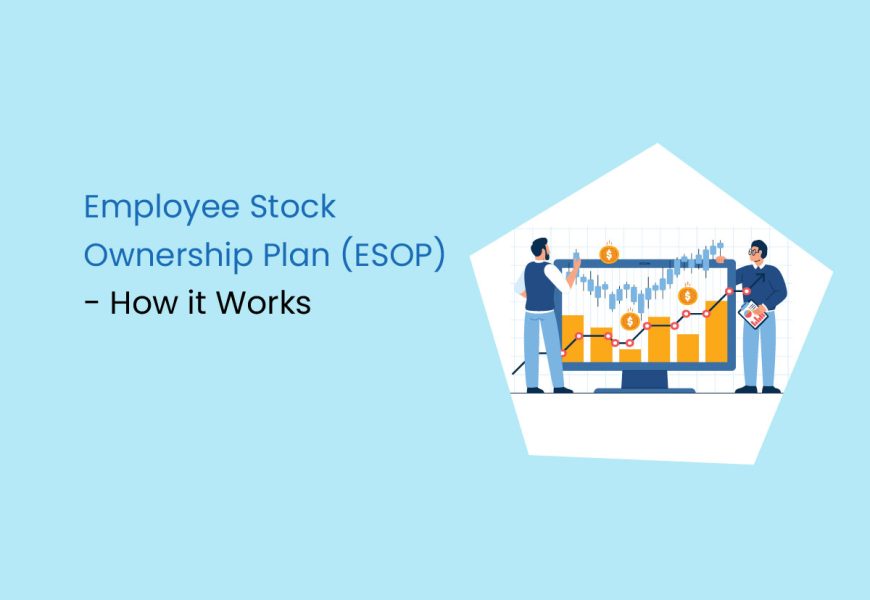An Employee Stock Ownership Plan (ESOP) functions as a unique employee benefit plan, empowering staff members to become partial or complete owners of the company they are employed with. Primarily utilised for seamless succession planning, ESOPs offer a strategic avenue for business owners to sell their shares and transition smoothly out of the company. This transition ensures a flexible exit for the owner and facilitates a range of benefits for both the employees and the organisation.
This article shall cover the basics of the topic and everything else you may need to know. Read on to explore!
What is an Employee Stock Ownership Plan (ESOP)?
An Employee Stock Ownership Plan (ESOP) is an employee benefit plan that grants employees an ownership stake in the organisation. These plans can take the form of direct stock issuance, profit-sharing plans, or bonuses, and it is entirely at the discretion of the employer to determine eligibility for these options. It’s important to note that employee stock ownership plans are essentially purchasable options, available at a predetermined price before the exercise date. The Companies Rules outline specific regulations employers must adhere to when offering employee stock ownership plans to their workforce.
ESOPs have proven to be instrumental in fostering higher productivity levels, enhancing employee retention rates, and providing distinct tax advantages. The ownership structure of ESOPs tends to contribute positively to employee job satisfaction. Additionally, these plans appeal to companies as they serve as a dynamic financial tool. By selling company stock to the ESOP, businesses can generate cash flow that can be utilised to settle debts or support various financial initiatives.
Furthermore, ESOPs play a pivotal role in financing strategies, offering companies a viable means to leverage their stock for financial stability and growth. The synergy between employee ownership and business financials creates a win-win situation that goes beyond traditional ownership models.
In light of these advantages, ESOPs stand out as a succession planning tool and as a strategic move for fostering a more engaged and financially sound work environment.
How Does An ESOP Work?
An organisation extends Employee Stock Ownership Plans (ESOPs) to its employees, providing them the opportunity to acquire a specified number of company shares at a predetermined price after a designated option period, typically spanning a specific number of years. However, before an employee can exercise their option, they are required to undergo a predetermined vesting period, during which they must remain employed by the organisation to be eligible to exercise a portion or the entirety of the stock options.
ESOPs empower employees to procure company stock at prices set below the prevailing market value. This arrangement not only allows employees to invest in the company but also presents the option to sell the acquired shares, enabling them to capitalize on their investments.
In the event of an employee departing or retiring before completing the vesting term, the organisation is obligated to repurchase the ESOP at its fair market value within a stipulated 60-day period. This mechanism ensures a fair and transparent process in the event of an employee’s early exit or retirement, safeguarding both the employee’s interests and the organisation’s equity structure.
Cost of an ESOP
The initiation of an Employee Stock Ownership Plan (ESOP) in India encompasses various costs, including legal fees, accounting fees, and administrative expenditures. These initial costs contribute to the establishment of the ESOP and are dependent on factors such as the plan’s size and complexity.
Establishing and maintaining an ESOP is not a one-size-fits-all scenario; rather, the associated costs vary based on the specific characteristics and intricacies of the plan in question.
In the context of ESOP distributions in India, employees are presented with multiple options. Upon exercising their stock options to acquire shares, individuals have the flexibility to either sell them immediately or retain them for future potential appreciation.
Opting to sell the acquired shares results in the employee receiving the proceeds, with any applicable taxes on gains deducted. Conversely, if an employee chooses to retain the shares, they effectively become partial owners of the company. This ownership stake may entitle them to dividends or potential capital gains should the stock price experience an increase over time.
In essence, the cost dynamics of ESOPs involve not only the initial setup expenses but also considerations for ongoing maintenance, while the distribution phase offers employees a strategic choice between immediate financial gain or long-term ownership and potential dividends.
Advantages of an ESOP
ESOP shares, being an integral part of employees’ remuneration packages, serve as a strategic tool for companies to align the interests of plan participants with corporate performance and share price appreciation. This alignment is designed to keep employees focused on contributing to the overall success of the company.
By integrating ESOPs into the compensation structure, companies aim to instil a sense of ownership among plan participants. This ownership interest is believed to motivate employees to prioritise actions that benefit shareholders, as the employees themselves become shareholders with a vested interest in the company’s stock performance.
For employees, participation in ESOPs offers a distinct avenue to augment their income, enhance overall compensation, and essentially receive tangible rewards for their hard work and dedication. The prospect of having a stake in the company creates a sense of appreciation among employees, potentially adding excitement to their work routine.
ESOPs, with their inherent incentive structure, work as a mechanism to encourage employees to give their utmost effort. This alignment of interests benefits individual employees and contributes to the company’s overall success, creating a symbiotic relationship where the success of the employees and the organisation are intertwined.
Why Give ESOPs?
For Employers
Companies offer Employee Stock Ownership Plans (ESOPs) as a strategic tool to attract and retain high-caliber employees. These plans are often structured to be distributed incrementally, providing employees with stocks as part of their overall compensation. For example, a company might grant stocks to employees at the close of the financial year, creating an incentive for them to remain with the organization and receive the grant.
ESOPs play a crucial role in companies’ long-term objectives. Beyond the immediate goal of retaining employees, companies aim to transform their workforce into stakeholders. This approach is particularly significant in industries, such as information technology, where attrition rates can be high. By offering ESOPs, companies seek to mitigate attrition and foster a sense of loyalty among employees.
In the context of start-ups, where financial resources may be limited, ESOPs serve as a valuable tool for attracting talent. Start-ups, often constrained in offering competitive salaries, leverage ESOPs to make their compensation packages more appealing. By providing employees with a stake in the organisation, these companies align the interests of the workforce with the long-term success and growth of the business. In essence, ESOPs serve as a multifaceted strategy for talent acquisition and retention and for fostering a sense of ownership and commitment among employees.
For Employees
From an employee’s standpoint, Employee Stock Ownership Plans (ESOPs) offer a unique opportunity to acquire company shares at a nominal rate, presenting a pathway to potential profits upon selling them, typically after a specified tenure set by the employer. The allure of ESOPs lies in the success stories where employees have not only realised financial gains but have also shared in the wealth creation alongside company founders.
One striking example is the case of Google when it went public. The founders, Sergey Brin and Larry Page, became some of the wealthiest individuals globally. What makes this narrative compelling is that even the rank-and-file employees who held stocks through ESOPs experienced significant financial windfalls, earning millions in the process.
ESOPs, from the employee’s perspective, transcend beyond traditional compensation structures. They represent a chance for individuals to become direct stakeholders in the success of the company, creating an alignment of interests between employees and the organisation’s founders. The potential for financial prosperity, coupled with the shared success stories of those who have benefited, adds a layer of motivation and excitement for employees participating in ESOPs.
ESOP Taxation
ESOP taxation involves a dual impact, affecting employees at the time of exercising their rights to purchase company stock and subsequently when selling the acquired shares. Let’s delve into each scenario:
Tax Treatment at the Time of Buying the Shares
When employees exercise their rights to purchase shares after the vesting date, acquiring them at a price lower than the Fair Market Value (FMV) on that date, the disparity between the FMV and the exercise price is regarded as a prerequisite in the employee’s hands. This difference is then taxed at the individual’s applicable income tax slab rate.
However, for employees in new businesses, the government has eased the tax implications associated with ESOPs. In such cases, employees are not obligated to pay tax on the perk in the year of exercising the ESOP. The Tax Deducted at Source (TDS) on ESOPs is deferred until the earlier of two dates: five years from the ESOP grant date or the employee’s departure from the company.
Tax Treatment at the Time of Selling the Shares
When an employee decides to sell the acquired shares, the taxable amount is determined by the difference between the selling price and the FMV on the date the shares were exercised. This difference is classified as capital gains.
If the shares are sold within a year of purchase, a 10% tax is imposed on profits exceeding Rs.1 lakh. For shares sold after 12 months, the applicable tax rate increases to 15%.
The taxation process for foreign ESOPs in India mirrors the domestic scenario, with individuals being taxed in India on the perquisites earned from a foreign company. This ensures a consistent approach to ESOP taxation regardless of the company’s origin.
Benefits for Employers for ESOPs
ESOPs offer a range of benefits for employers, extending beyond mere motivation and employee retention. Here are some noteworthy advantages that organisations can derive from implementing Employee Stock Ownership Plans:
Motivation and Employee Retention
- ESOPs serve as a powerful motivational tool for employees, aligning their interests with the company’s success. When employees have a stake in the company’s share prices, it incentivises them to put forth their best efforts.
- The prospect of financial gains through ESOPs enhances employee retention, as individuals are more likely to stay committed to a company where their hard work directly contributes to their financial well-being.
Non-Cash Rewards
- ESOPs provide a non-cash form of recognition and reward for employees. This allows organisations to acknowledge and appreciate employee contributions without an immediate cash outflow.
- By offering stock options, companies can conserve cash resources while still providing valuable incentives to employees.
Cost-Effective for Start-ups and Expanding Businesses
- For organisations embarking on significant business operations or expanding their reach, ESOPs offer a cost-effective alternative to cash rewards.
- Instead of immediate cash outlays, companies can grant ESOPs, aligning employee interests with the company’s growth and success.
Long-Term Employee Commitment
- ESOPs foster a sense of long-term commitment among employees, as they become vested in the company’s success over time. This commitment can contribute to a stable and dedicated workforce.
Attraction of High-Quality Talent
- The promise of stock options can make a company more attractive to high-quality talent, especially in competitive industries where skilled professionals seek comprehensive compensation packages.
Employee Participation in Decision-Making
- ESOPs can encourage a sense of ownership and involvement among employees, leading to increased participation in decision-making processes and a stronger sense of engagement with the company’s objectives.
What will happen to ESOPs when the company is listed?
When a company goes public or is listed on the stock exchange, it can have several implications for Employee Stock Ownership Plans (ESOPs). Here’s what typically happens to ESOPs when a company becomes publicly traded:
- Increased Liquidity: Going public provides employees with increased liquidity for their ESOP shares. In a publicly traded company, employees can sell their shares on the open market, making it easier to cash out their holdings compared to an unlisted company.
- Market-Determined Fair Market Value (FMV): The Fair Market Value (FMV) of the company’s stock is now determined by the market through the buying and selling activities on the stock exchange. This market-driven valuation can provide employees with a more transparent and dynamic assessment of the value of their ESOP shares.
- Easier Selling Process: With the company being listed, employees no longer face the challenge of limited purchasers for their ESOP shares. The stock is now traded on the exchange, allowing employees to sell their shares more easily.
- Tax Implications: The tax implications may change after the company is listed. While the timing of the sale still influences the tax rate, the market-driven valuation can affect the calculation of capital gains. Short-term capital gains (for shares sold within 36 months of exercising) are generally taxed at the individual’s applicable income tax rate. Long-term capital gains (for shares sold after 36 months) are taxed at a different rate, usually 20%, with the option for indexation.
- Additional Opportunities for Employees: Listing opens up additional opportunities for employees to participate in the growth of the company. As the company’s stock is now subject to market fluctuations, employees may benefit from potential increases in share prices.
ESOP and Other Forms of Employee Ownership
Employee ownership comes in various forms, each offering unique benefits and aligning with the corporate culture desired by company management. In addition to Employee Stock Ownership Plans (ESOPs), there are several other forms of employee ownership, each catering to different preferences and objectives:
- Direct Stock Purchase Plan (DSPP): DSPP allows employees to buy shares of their company using personal after-tax funds. Some countries offer special tax-qualified plans that enable employees to purchase company stock at discounted prices.
- Restricted Stock: Restricted stock grants employees the right to receive shares either as a gift or a purchased item after meeting specific conditions. These conditions may include working for a designated period or achieving predefined performance targets.
- Stock Options: Stock options provide employees with the opportunity to purchase company shares at a predetermined price within a specified period. This option allows employees to benefit from potential stock appreciation.
- Phantom Stock: Phantom stock operates by providing cash bonuses tied to good employee performance. The bonus amount corresponds to the value of a specific number of shares, even though no actual shares are granted.
- Stock Appreciation Rights (SARs): SARs give employees the right to receive an increase in the value of a designated number of shares. Companies typically settle these rights by paying employees in cash rather than issuing additional shares.
Each of these forms of employee ownership serves as a tool for companies to foster a sense of ownership, motivation, and alignment of interests between employees and the organization. The choice of the specific plan depends on the company’s goals, the desired level of employee participation, and the prevailing regulatory and tax considerations in the respective jurisdiction.
FAQs on ESOP
What is ESOP, and how does it work?
ESOP, or Employee Stock Ownership Plan, is an employee benefit plan that provides employees with an ownership interest in the organisation. These plans can be issued as direct stock, profit-sharing plans, or bonuses. The employer has sole discretion in determining who can avail of these options. The two key dates in ESOP are the vesting date and the grant date.
Is an ESOP good for employees?
ESOPs are generally beneficial for both employers and employees, fostering increased effort and commitment in exchange for significant financial rewards. However, understanding the terms of the specific ESOP plan is crucial, as they may not always be straightforward and can be frustrating if not fully comprehended.
How is ESOP calculated?
To calculate your ESOP value, subtract the exercise price from the current market value of the shares. This formula provides a straightforward way to determine the value of the employee's stock options.
Who is eligible for ESOP?
Excluding directors and promoters with more than 10% equity, every employee is eligible for ESOP. Eligibility extends to full-time or part-time Directors of the Company, ensuring a broad scope for employee participation.
Is ESOP taxable?
Yes, any profit arising from the sale of shares allotted under the Employee Stock Option Plan (ESOP) is taxed under the 'Capital Gains' head in India. ESOP, being an employee benefit plan, allows employees to acquire company stock at a reduced cost.





















